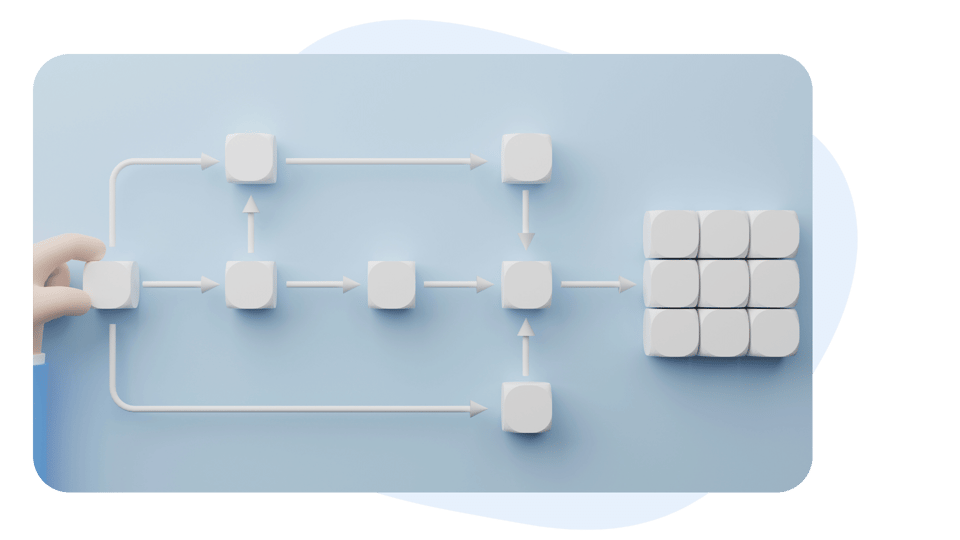

PRODUTO
SOLUÇÕES
por caso de utilização
aprende mais
ModelosBlogueVídeosYoutubePREÇOS
RECURSOS
COMUNIDADES E REDES SOCIAIS
PARCEIROS

Key takeaways:
Workflow automation is the process of using technology to automate manual, repetitive tasks and processes in business operations, streamlining workflows for greater efficiency and accuracy. This involves the use of software and tools to create, optimize, and manage workflows, reducing the need for human intervention and increasing productivity across various functions.
Workflow automation stands as a pivotal component in modern business efficiency, streamlining processes such as the ecommerce sales pipeline by reducing manual tasks and enhancing consistency across operations. This concept isn't just a buzzword; it's an actionable strategy that leverages technology, such as an automation platform, to automate tasks within business processes and create a more cohesive and less error-prone workflow process environment. From the basics of its definition to a practical tutorial that guides project managers through implementation, understanding how to automate tasks with workflow automation is essential for any organization looking to thrive in the digital age, especially in marketing. Coupled with the right automation platform, companies can automate their workflow process, transforming operations into models of productivity and precision for project managers.
In this exploration of workflow automation, we delve into not only what it entails but also how you can automate tasks effectively within your own enterprise using some of the most sophisticated yet user-friendly apps available today.

Workflow automation refers to the design, execution, and automation of processes based on predefined rules to streamline tasks and integrate apps, particularly in marketing. These processes automate workflow rules where human tasks, data or files are routed between people or systems, including apps, based on pre-defined business rules, often orchestrated by project managers using tools. With workflow automation through tools, repetitive tasks are eliminated, allowing project managers to focus on complex work without worrying about pricing.
Businesses use technology to streamline these workflows. They integrate software that automates these tasks and manages these flows from start to finish without manual intervention for project managers. This results in increased efficiency and a reduction in errors as managers automate project tasks.
Technology is pivotal for effective workflow automation. It enables managers to transform manual tasks into automated sequences for a project using zap. Advanced software tools can trigger actions, move information and make decisions swiftly.
These tools connect various applications within an organization’s ecosystem. They allow for seamless data exchange and process management across different platforms.
Manual workflows in project tasks involve human input at every stage, including managers, which can be time-consuming and prone to error over the course of a month. In contrast, automated workflows rely on algorithms and programmed instructions.
Automated systems can perform tasks around the clock without fatigue or downtime due to human limitations, month after month. Consequently, they offer greater consistency in task execution than their manual counterparts.
When starting with workflow automation, it's crucial to identify business processes that will benefit from automation. Look for tasks that are repetitive and time-consuming. These often include data entry, email notifications, and scheduling.
For example, an HR department might automate onboarding processes. This could mean setting up automatic emails to new hires with necessary paperwork or scheduling orientation sessions without human intervention.
Setting clear objectives is essential before implementing workflow automation. Objectives guide the process and provide a way to measure success. They should be specific, measurable, achievable, relevant, and time-bound within a month (SMART).
Consider a sales team automating their lead nurturing process. Their objective might be to reduce response time from 24 hours to 2 hours using automated emails.
Stakeholder involvement in planning cannot be overstated. Engage those who will use the automated workflows daily. Gather their input on what needs improvement.
In a manufacturing setting where supply chain management is being automated, involving warehouse managers will ensure the system meets real-world needs.

The first step in implementing automated workflows is to establish clear goals. Identify the outcomes you desire from automation. This could be faster processing times, reduced errors, or improved communication among team members. Once goals are set, select a workflow automation tool that fits your needs. There are many options available such as Asana’s Automations feature, and Microsoft Power Automate.
Next is setting up user access and permissions within the chosen tool. Ensure only authorized personnel can create or modify workflows. This maintains system integrity and security.
Before digitizing processes, it's crucial to map them out thoroughly. Start by documenting each step of the current process manually if necessary. Understand who is responsible for what and how information flows between steps.
Use diagrams or flowcharts to visualize existing processes clearly; tools like Lucidchart or Microsoft Visio can assist with this task. By mapping out these details beforehand, potential issues can be identified early on which will save time during implementation.
After setting up your automated workflows based on mapped-out processes, testing becomes critical for success. Begin with small test groups before rolling out across larger teams or departments to catch any problems early on without impacting productivity significantly.
Monitor performance closely during testing phases—look for bottlenecks where tasks might get delayed unnecessarily due to poor design in the workflow structure itself rather than external factors like employee error or technical glitches outside of one's control within software systems used alongside these newly implemented automated solutions being tested here today!
It's also essential to gather feedback from users at this stage;
To ensure workflow automation remains effective, continuous monitoring is crucial. This involves regularly checking automated processes to identify and address inefficiencies or errors. For instance, a company might use analytics tools to track how much time each step in an automated process takes and compare it with historical data.
By doing so, businesses can spot trends that indicate potential problems or areas for improvement. It's not enough to set up automation and forget it; like any system, it requires oversight to maintain optimal performance.
Automation doesn't eliminate the need for skilled employees; rather, it changes their roles within the workflow. Therefore, regular training sessions are essential. They keep staff updated on new tools and techniques in automation technology.
Training can take many forms: from workshops introducing new software features to cross-training among departments to foster a more versatile workforce. An employee who understands the ins and outs of an automated system can work more efficiently within its parameters and contribute valuable feedback for further improvements.
When designing automated workflows, simplicity should be your guiding principle. Complex systems are harder to monitor, update, and use effectively. Aim for clarity by ensuring each part of the workflow has a clear purpose without unnecessary steps.
A simple design also makes troubleshooting easier when issues arise since there are fewer variables involved in each process stage. Moreover, users find straightforward systems less intimidating and more approachable which leads to better adoption rates across your organization.

Workflow automation tools must seamlessly integrate with existing systems. This allows for a fluid exchange of data and processes across various applications. For example, integrating with CRM software can automate customer follow-ups.
Tools that lack this feature may lead to fragmented workflows and increased chances of bottlenecks.
Scalability is another aspect tied to integration. As businesses grow, their tools should adapt accordingly without the need for major overhauls or replacements.
Access to real-time analytics is essential in workflow automation tools. It enables immediate insights into process performance and identifies areas needing improvement.
These analytics help in:
Without these metrics, organizations might miss out on opportunities to optimize their workflows effectively.
A user-friendly interface simplifies interaction with the tool. It ensures that users can easily navigate through features without extensive training. A complicated interface could deter users from fully adopting the tool, negating its benefits.
The importance lies in:
If users find it difficult to engage with the software, they are less likely to utilize its full potential.
Workflow automation solutions should offer scalability and customization options. These features allow businesses to tailor their workflow processes as per changing needs without significant disruptions or costs involved.
Customization helps cater specifically to business requirements by allowing:
Lack of scalability could result in inefficiencies as companies expand or change directions, while insufficient customization may leave specific business needs unaddressed.
Workflow automation tools vary in price, often reflecting their complexity and feature set. Cost-effective solutions may suit small businesses with limited needs. In contrast, large organizations might benefit from more robust systems, despite higher costs.
A popular low-cost option is Zapier, known for its user-friendly interface and wide range of integrations. On the other hand, Microsoft Power Automate offers advanced features suited for enterprises but at a steeper price point. Businesses must weigh initial expenses against long-term gains like increased efficiency and reduced manual errors.
User reviews provide valuable insights into software reliability. High ratings typically indicate satisfied users who have experienced tangible benefits from the tool.
For instance, many users praise Asana for its intuitive design that streamlines project workflows effectively. Conversely, some report challenges with Salesforce's automation features which can be complex to navigate without proper training or support.
It's essential to consider feedback on customer service quality as well—prompt and helpful support can significantly enhance the user experience.
The ability of workflow automation software to integrate seamlessly with existing systems is crucial. A mismatch can lead to productivity losses rather than gains.
Tools like Trello are praised for their adaptability across various platforms and applications—a key advantage in diverse tech environments. Meanwhile, specialized options such as HubSpot excel when paired with marketing-centric infrastructures but may not fit all business models.
Organizations should conduct thorough compatibility checks before committing to ensure smooth operation within their current ecosystem.
Automated workflows transform departmental operations. In HR, they streamline the recruitment process. Resumes are sorted quickly. Candidates receive prompt responses. This efficiency attracts top talent.
Sales teams benefit too. Automation tracks leads and nurtures them systematically. Salespeople focus on closing deals, not administrative tasks.
Operations departments see improved task management. Processes like inventory control become more reliable with automation.
In finance, automated workflows ensure accuracy in reporting. Algorithms detect discrepancies faster than humans can.
Compliance is another area where errors have high stakes. Automation standardizes data handling, reducing risks of non-compliance fines or reputational damage.
Workflow automation enhances interdepartmental communication as well. Notifications keep team members informed without delay. Approval processes get streamlined through automatic routing to relevant stakeholders. This coordination fosters a culture of transparency and accountability across an organization.

To gauge workflow automation's effectiveness, businesses must track specific metrics both before and after implementation. Key performance indicators (KPIs) to monitor include:
By comparing these values pre-and post-automation, companies can quantify improvements. For instance, a reduction in time spent on data entry directly correlates with increased capacity for value-added activities.
Another metric is the volume of work processed. With automation in place, organizations often experience a surge in throughput without compromising quality. This increase is quantifiable and indicative of enhanced efficiency.
Return on Investment (ROI) calculation is crucial for justifying any business expenditure. In workflow automation, ROI involves assessing both tangible and intangible benefits against the costs incurred during implementation.
A simple formula to calculate ROI is:
ROI = (Net Benefits / Cost of Investment) x 100%
For workflow automation, net benefits might include labor savings from reduced manual work or improved revenue from faster processing times.
It’s important to consider long-term gains too, such as ongoing cost reductions from eliminating paper-based systems or revenue uplifts due to better customer experiences enabled by streamlined workflows.
Case studies offer concrete examples of how workflow automation impacts efficiency. A notable case involved a retail company that automated its inventory management system. Post-implementation tracking showed:
These figures translated into significant cost savings and higher customer satisfaction due to more reliable stock availability information.
In another example, an insurance firm automated claim handling processes resulting in:
Both cases demonstrate not only direct efficiency gains but also secondary effects like improved employee morale due to less tedious workloads and better service outcomes for customers.
Workflow automation is set to evolve significantly. Artificial intelligence (AI) will play a pivotal role. Tools will harness AI to predict user needs and streamline tasks. This means more intuitive interfaces and smarter systems.
Imagine software that not only automates but also suggests workflow improvements. It learns from patterns and anticipates problems before they occur. This isn't just convenient; it's transformational.
The shift towards remote work has been rapid. Businesses now depend on digital tools for team collaboration. As this trend continues, the adoption of workflow automation will surge.
Remote teams need efficient workflows to stay productive. They benefit from automated scheduling, task assignments, and progress tracking. These features keep everyone aligned, regardless of location.
In a world where we switch between devices seamlessly, cross-platform compatibility becomes essential. Users expect their workflow tools to work everywhere - on laptops, tablets, or phones.
Developers are responding by creating more agile applications that sync across platforms without hiccups - a trend likely to strengthen over time.
Workflow automation stands as a transformative force in modern workspaces, integrating efficiency and precision across various departments. This article has delineated its definition, outlined a comprehensive tutorial, and reviewed pivotal tools that facilitate seamless integration of automated workflows. By adopting best practices and leveraging key features of sophisticated software, organizations can significantly enhance their operational efficacy.
The future of workflow automation promises further advancements, with technology continually evolving to meet dynamic business needs. As companies strive to remain competitive, the adoption of such innovations is not just beneficial but essential. Readers are encouraged to evaluate their current processes and consider the integration of workflow automation solutions, like those offered by Latenode, to optimize performance and stay ahead in the ever-changing business landscape. Latenode provides cutting-edge tools and expertise to seamlessly implement workflow automation, ensuring your business can efficiently adapt and thrive in the digital era. Explore Latenode's solutions today to transform your business processes for tomorrow.
Artigos relacionados:



